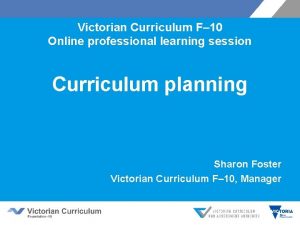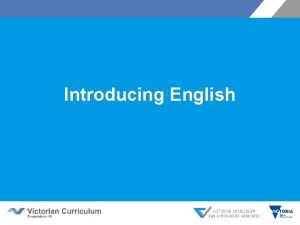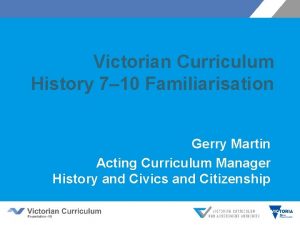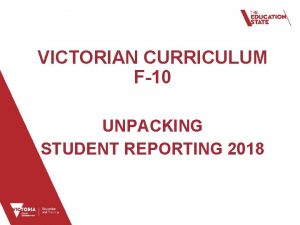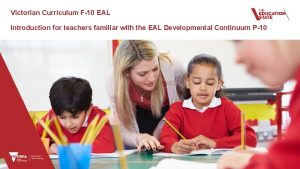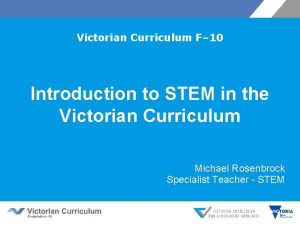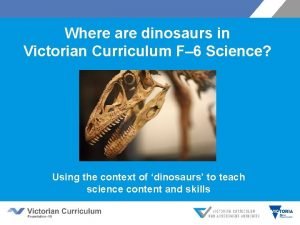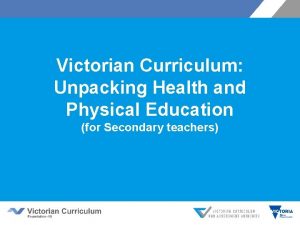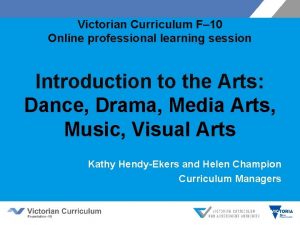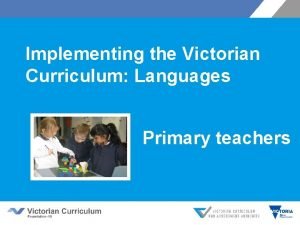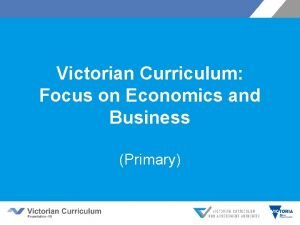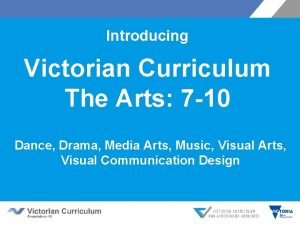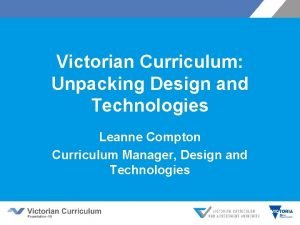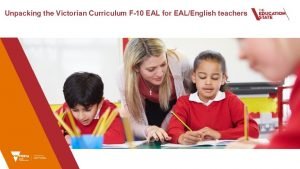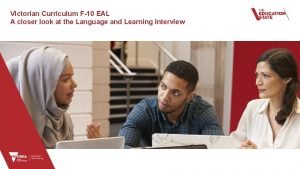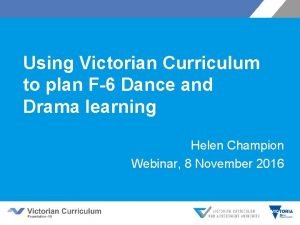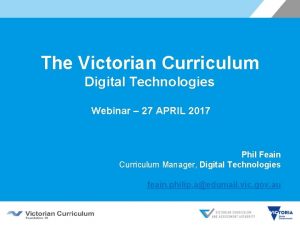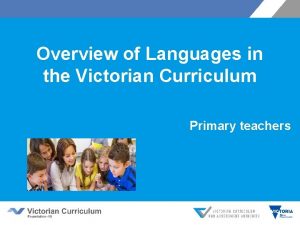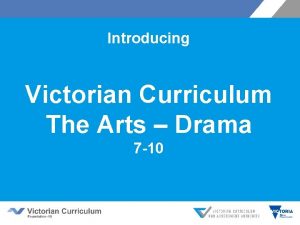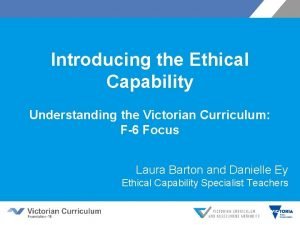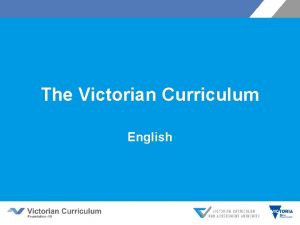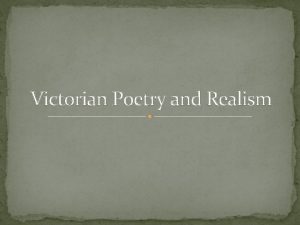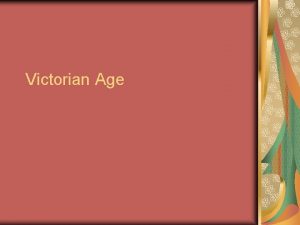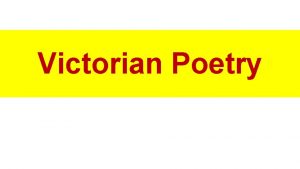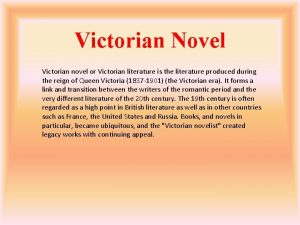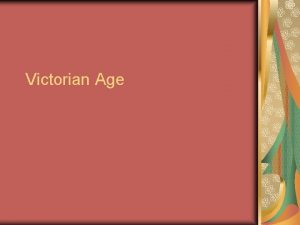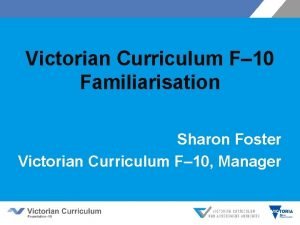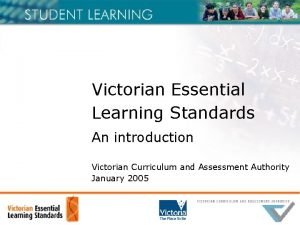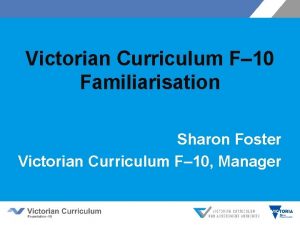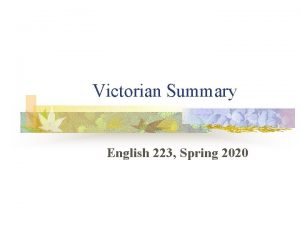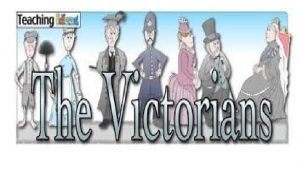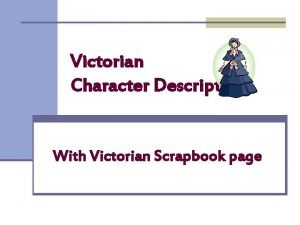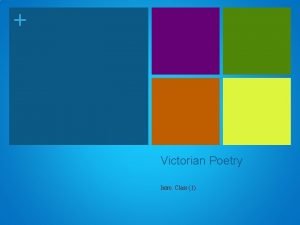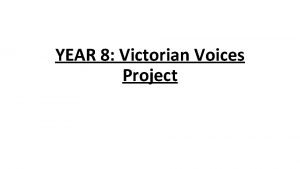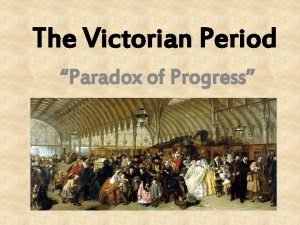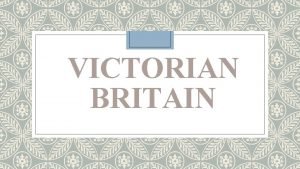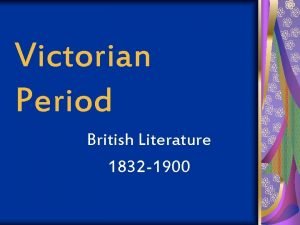The Victorian Curriculum English F6 The Victorian English




























- Slides: 28

The Victorian Curriculum English F-6


The Victorian English Curriculum F- 6 • released in September 2015 as a central component of the Education State • provides a stable platform for the development and implementation of whole-school teaching and learning programs • the Victorian Curriculum F- 6 incorporates the Australian Curriculum and reflects Victorian priorities and standards http: //victoriancurriculum. vcaa. vic. edu. au/

The Victorian English Curriculum F-6 ‘In most schools, the mandated curriculum will not constitute the whole teaching and learning program. This enables schools to develop particular specialisations and areas of expertise and innovation while ensuring the mandated curriculum is delivered. ’

Aims The English curriculum aims to ensure that students: • learn to listen to, read, view, speak, write, create and reflect on increasingly complex and sophisticated spoken, written and multimodal texts across a growing range of contexts with accuracy, fluency and purpose • appreciate, enjoy and use the English language in all its variations and develop a sense of its richness and power to evoke feelings, convey information, form ideas, facilitate interaction with others, entertain, persuade and argue • understand how Standard Australian English works in its spoken and written forms and in combination with non-linguistic forms of communication to create meaning • develop interest and skills in inquiring into the aesthetic aspects of texts, and develop an informed appreciation of literature.

Conceptual structure Study of literary texts of personal, cultural, social and aesthetic value Knowledge of the English language and how it works Language Literature Content descriptions and elaborations Literacy Interpret and create texts with appropriateness, accuracy, confidence, fluency and efficacy for a range of contexts The first achievement standard at Foundation and then at Levels 1, 2, 3, 4, 5, 6, 7, 8, 9 and 10 Reading and viewing Writing Speaking and listening Students will demonstrate their knowledge and skills through three language modes

Strands of learning in English Strand Sub-strands Language variation and change Literature and context Literacy Texts in context Language for interaction Text structure and organisation Expressing and developing ideas Phonics and word knowledge Responding to literature Interacting with others Examining literature Interpreting, analysing, evaluating Creating literature Creating texts

Features of the Victorian curriculum • A continuum of learning − Structured as a continuum across levels of learning achievement not years of schooling. • The cumulative curriculum − Students gradually develop their knowledge and skills with language over time. − For example, students learn about nouns and then gradually build on that knowledge to apply it in more sophisticated way across subsequent levels of the curriculum. • The spiralling curriculum − Students apply their knowledge and skills in different texts and contexts. − For example, students investigate the role of nouns in narrative texts, then later in persuasive texts.

From Aus. VELS English to Victorian Curriculum English Substantially similar to Aus. VELS English, with the majority of the curriculum unchanged. • Some changes have been made to strengthen particular areas and clarify others. − The Sound and Letter Knowledge sub-strand (previously located in the Language strand) has been renamed as Phonics and Word Knowledge and is comprised of three focus areas: o Phonological and phonemic awareness o Phonic knowledge o Spelling. − The Purpose and Audience focus area from within the Interpreting, Analysing, Evaluating sub-strand has been deleted to avoid duplication of content. − Content descriptions within the Interacting with others sub-strand have been combined and consolidated. − No changes to Achievement Standards in Levels 7 -10.

General capabilities The Victorian Curriculum F– 10 design does not include these three general capabilities as separate learning areas: • Literacy • Numeracy • Information and Communication Technologies (ICT).

Phonics and word knowledge Level F Reading and Viewing ‘Blend sounds associated with letters when reading consonant-vowel-consonant words’ (VCELA 147) Speaking and Listening ‘Blend and segment onset and rime in single syllable words (first consonant sound, last consonant sound, middle vowel sound)’ (VCELA 169)

Phonics and word knowledge Level 1 Reading and Viewing Recognise short vowels, common long vowels and consonant digraphs and consonant blends (VCELA 181) Writing Understand how to use visual memory to write high-frequency words, and that some high-frequency words have regular and irregular spelling components (VCELA 184) Speaking and Listening Identify the separate phonemes in consonant blends or clusters at the beginnings and ends of syllables (VCELA 203) Manipulate phonemes by addition, deletion and substitution of initial, medial and final phonemes to generate new words (VCELA 204)

Structure

A 3 format scope and sequence charts Structure

The Language strand knowledge of the English language and how it works Sub-strands Register Language variation and change Expressing and developing ideas Language for interaction Text structure and organisation Phonics and word knowledge everyday specialised technical informal more spoken like field formal tenor more written like mode

Planning discussion • What kinds of language knowledge do teachers most need in order to teach this part of the curriculum effectively?

Key language knowledge • Phonics and phonemic awareness • Functional grammar (as opposed to traditional grammar)

The Literature strand the study of literary texts of personal, cultural, social and aesthetic value Sub-strands Literature and context Responding to literature Examining literature Creating literature Texts which: • have the potential for enriching the lives of students • expand the scope of their experience • represent effective and interesting features of form and style.

Possible approaches to the study of literature: • Cultural studies - different ways in which literature is significant in everyday life • Structuralism - close analysis of literary works and the key ideas on which they are based (eg. detailed stylistic study of differing styles of literary work) • Comparativism - comparisons of works of literature from different language, ethnic and cultural backgrounds • Historicism - exploring the relationships between historical, cultural and literary traditions.

Planning discussion • What are the key questions to ask when selecting literary texts for class-room study in Levels 7 -10?

Key questions • What literary texts do we have on our list? • On what basis have we selected these texts? • Do these texts allow for rich literary analysis? • Have we selected a suitable range of texts?

The Literacy strand The ability to interpret and create texts with appropriateness, accuracy, confidence, fluency and efficacy for learning in and out of school, and for participating in Australian life more generally Sub-strands Texts in context Interacting with others Interpreting, analysing and evaluating Creating texts

Planning discussion How can we maximise the literacy development of our students within and beyond the English curriculum?

Literacy opportunities • Multi-modal and non-literary texts should be selected for study • Work in/from other learning areas can provide opportunities to teach content from the literacy strand provide evidence of learning

Literacy across the curriculum • Literacy is foundational to all learning areas and capabilities in the Victorian Curriculum. • It is not one of the four capabilities which have separately articulated content descriptions and achievement standards. • Students develop knowledge and skills across the Language and Literacy strands of the English curriculum. • Much of the explicit teaching of literacy occurs in the English learning area, however, it is strengthened, made specific and extended in other learning areas as students engage in a range of learning and assessment with significant literacy demands. • Resources will be prepared to support teachers to understand the language demands of different learning areas, and demonstrate how English content descriptions apply to particular texts.

Possible steps for integrating the Victorian Curriculum 1. whole-school audit of current programs 2. preparation of Scope and Sequence - we asked our teams to break the scope and sequence down into Skills (what the students learn to do) and Knowledge (what they learn about 3. definition of units – use mapping template 4. development of units 5. development of lesson sequence.

EAL • During 2016, the VCAA and DET is working in partnership to develop the Victorian Curriculum F– 10 English as an Additional Language (EAL), which will be aligned to the new Victorian Curriculum F– 10 English. • The curriculum will be accompanied by teaching and learning resources. • Building on the EAL Companion to Aus. VELS, the EAL Developmental Continuum P– 10 and findings from assessment research being undertaken by DET, the EAL curriculum will focus on the language skills needed by students for whom English is an additional language and will take account of the diverse nature of this group through multiple pathways for learning English and learning in English. • It is intended that the EAL curriculum will be available from Term 1, 2017.

Comments/Questions Jacqueline Moore | English Curriculum Manager T: (03) 9032 1691 E: moore. jacqueline. j@edumail. vic. gov. au
 Victorian curriculum progression points
Victorian curriculum progression points Year 10 victorian curriculum
Year 10 victorian curriculum Baroque flower arrangements
Baroque flower arrangements History of floral design crossword
History of floral design crossword Hpe vic curriculum
Hpe vic curriculum Victorian history curriculum
Victorian history curriculum Progression point scale victorian curriculum
Progression point scale victorian curriculum Victorian curriculum eal
Victorian curriculum eal Stem curriculum victoria
Stem curriculum victoria Vic curriculum music
Vic curriculum music Victorian curriculum economics
Victorian curriculum economics Different types of dinosaurs
Different types of dinosaurs Victorian curriculum health and physical education
Victorian curriculum health and physical education Victorian curriculum visual arts scope and sequence
Victorian curriculum visual arts scope and sequence Language
Language Victorian curriculum economics and business
Victorian curriculum economics and business Dance curriculum victoria
Dance curriculum victoria Critical and creative thinking vic curriculum
Critical and creative thinking vic curriculum Victorian curriculum technology
Victorian curriculum technology Eal curriculum victoria
Eal curriculum victoria Victorian curriculum intercultural capability
Victorian curriculum intercultural capability Victorian curriculum history
Victorian curriculum history Eal victorian curriculum
Eal victorian curriculum Victorian curriculum dance
Victorian curriculum dance Victorian curriculum art
Victorian curriculum art Digital technologies victorian curriculum
Digital technologies victorian curriculum Googliser
Googliser Victorian curriculum drama
Victorian curriculum drama Ethical capability
Ethical capability
